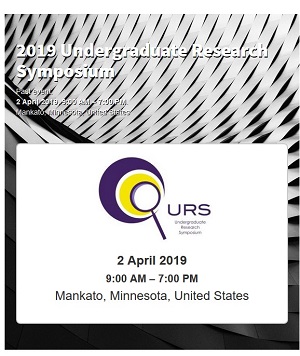Identification of Genes Involved in Cytophaga hutchinsonii Cellulose Utilization
Location
CSU Ballroom
Start Date
2-4-2019 10:00 AM
End Date
2-4-2019 11:30 AM
Student's Major
Biological Sciences
Student's College
Science, Engineering and Technology
Mentor's Name
Yongtao Zhu
Mentor's Department
Biological Sciences
Mentor's College
Science, Engineering and Technology
Description
Many members of the phylum Bacteroidetes can digest polysaccharides and thus are essential in carbon cycling in the environment. The soil BacteroidetesC.hutchinsonii is able to move by gliding motility on solid surfaces and is known to efficiently break down crystalline cellulose. The cellulolytic mechanism C.hutchinsonii undergoes to break down cellulose is not well known.
Analysis of the C.hutchinsonii genome revealed nine endoglucanases belonging to the glycoside hydrolase family 5 (GH5) and GH9, and six GH8 glycohydrolases. These enzymes are thought to be involved in cellulose utilization. The roles of GH5 and GH9 endoglucanases have been extensively studied. In this study, we will focus on the function of GH8 glycohydrolases in C. hutchinsonii cellulose utilization. CHU_1075, one of the GH8 glycohydrolase-encoding genes, will be deleted in the wild type C. hutchinsonii, and in mutants lacking the GH3 and GH9 endoglucanases. The growth rates of mutants lacking CHU_1075 on cellulose will be determined.
The role of gliding motility in C. hutchinsonii cellulose utilization is not clear. The ability to glide over surfaces might allow C. hutchinsonii cells to migrate along cellulose fibers and find the most amenable regions for enzymatic attack. The cell surface adhesin SprB is required for active gliding motility in other members of Bacteroidetes. Two sprB-like genes, CHU_2225 and CHU_0597, will be deleted in C. hutchinsonii in this study. We expect the mutant cells lacking sprB-like genes exhibit decreased gliding motility. Their ability to digest cellulose will be determined and compared to the wild type cells.
Identification of Genes Involved in Cytophaga hutchinsonii Cellulose Utilization
CSU Ballroom
Many members of the phylum Bacteroidetes can digest polysaccharides and thus are essential in carbon cycling in the environment. The soil BacteroidetesC.hutchinsonii is able to move by gliding motility on solid surfaces and is known to efficiently break down crystalline cellulose. The cellulolytic mechanism C.hutchinsonii undergoes to break down cellulose is not well known.
Analysis of the C.hutchinsonii genome revealed nine endoglucanases belonging to the glycoside hydrolase family 5 (GH5) and GH9, and six GH8 glycohydrolases. These enzymes are thought to be involved in cellulose utilization. The roles of GH5 and GH9 endoglucanases have been extensively studied. In this study, we will focus on the function of GH8 glycohydrolases in C. hutchinsonii cellulose utilization. CHU_1075, one of the GH8 glycohydrolase-encoding genes, will be deleted in the wild type C. hutchinsonii, and in mutants lacking the GH3 and GH9 endoglucanases. The growth rates of mutants lacking CHU_1075 on cellulose will be determined.
The role of gliding motility in C. hutchinsonii cellulose utilization is not clear. The ability to glide over surfaces might allow C. hutchinsonii cells to migrate along cellulose fibers and find the most amenable regions for enzymatic attack. The cell surface adhesin SprB is required for active gliding motility in other members of Bacteroidetes. Two sprB-like genes, CHU_2225 and CHU_0597, will be deleted in C. hutchinsonii in this study. We expect the mutant cells lacking sprB-like genes exhibit decreased gliding motility. Their ability to digest cellulose will be determined and compared to the wild type cells.
Recommended Citation
Owolabi, Barakallah; Bersabeh Tafesse; and Shamim Ahmed. "Identification of Genes Involved in Cytophaga hutchinsonii Cellulose Utilization." Undergraduate Research Symposium, Mankato, MN, April 2, 2019.
https://cornerstone.lib.mnsu.edu/urs/2019/poster-session-A/15



